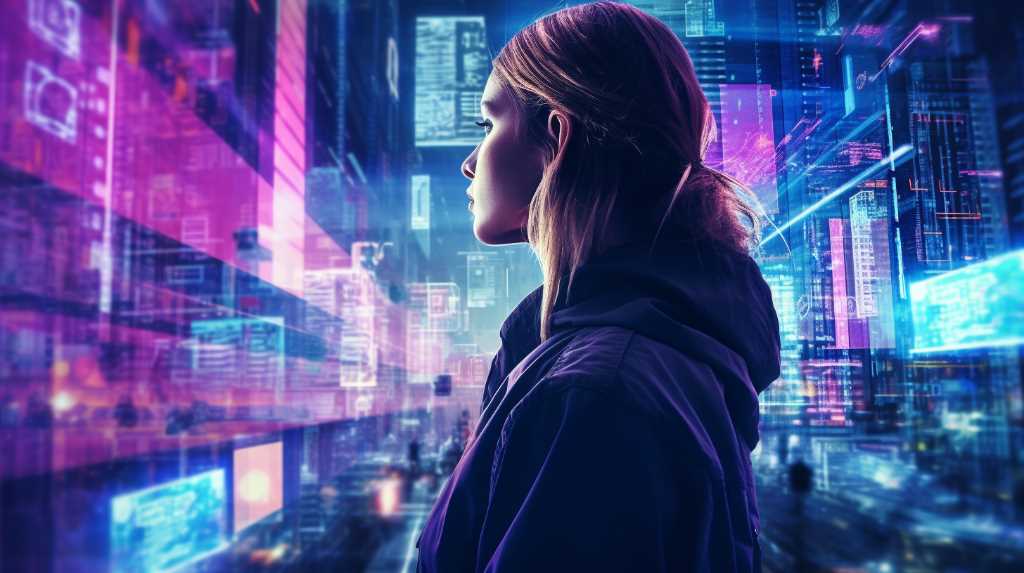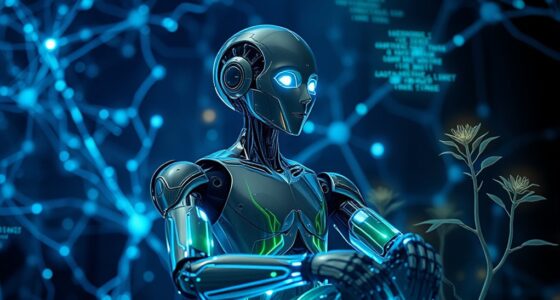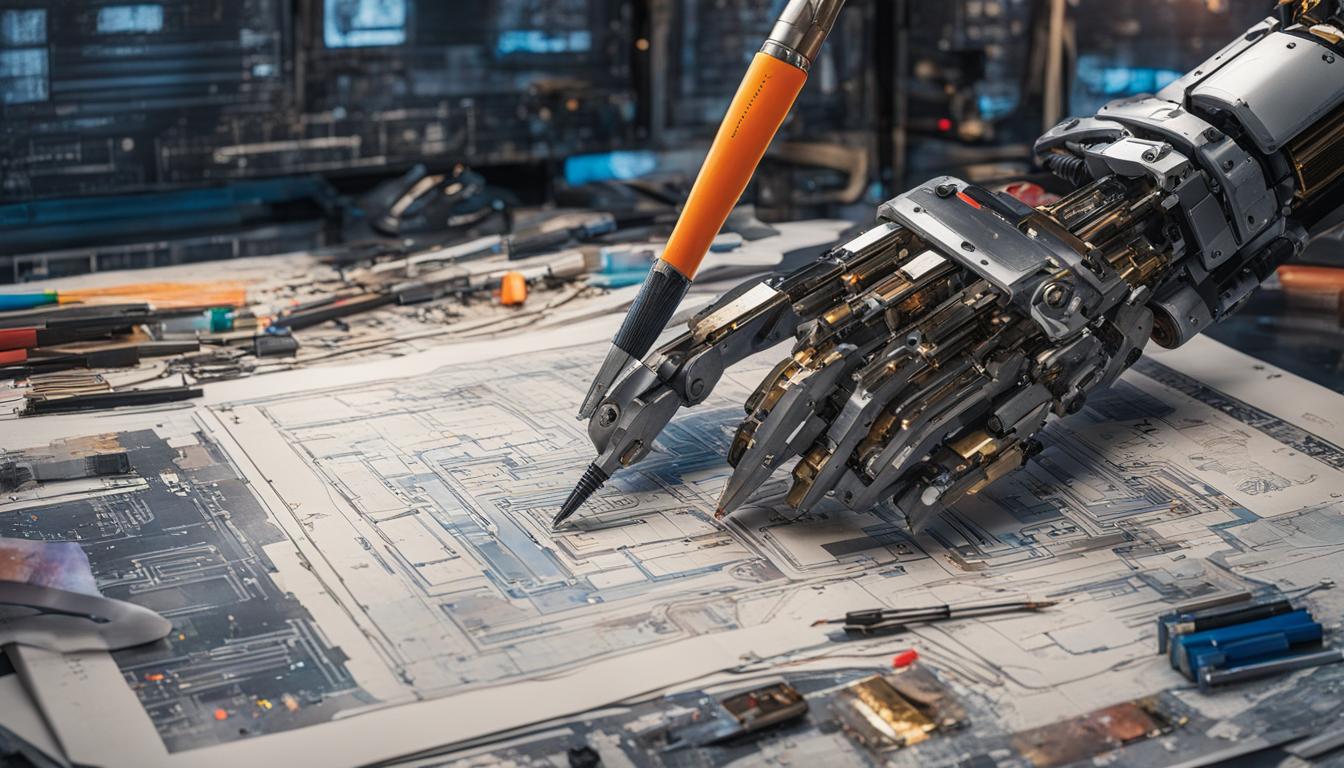We are about to embark on a journey that will push the boundaries of what we thought was possible in film and TV production.
Brace yourselves, because with the power of AI, we are about to witness a revolution unlike anything we’ve ever seen before.
From enhancing visual effects to streamlining pre-production processes, AI is set to transform the way we create and engage with content.
Get ready to master film and TV production with our futuristic guide to the incredible world of AI.

Key Takeaways
- AI enhances visual effects and CGI capabilities in film and TV production.
- AI streamlines the post-production process and improves accuracy and efficiency in editing.
- AI assists in scriptwriting and story development by generating ideas, analyzing audience preferences, and enhancing storytelling.
- AI optimizes production planning and logistics by predicting resource requirements, assisting in risk assessment, and improving efficiency in equipment and crew management.
Benefits of AI in Film Production
In our exploration of the futuristic guide to mastering film and TV production with AI, we find numerous benefits that AI brings to the realm of film production.
AI technology has revolutionized the industry by improving storytelling and optimizing production workflows. With AI, filmmakers can enhance the narrative structure and create compelling stories that resonate with audiences on a deeper level.
AI algorithms can analyze vast amounts of data, such as viewer preferences and trends, to generate valuable insights that inform the creative process. This enables filmmakers to make informed decisions and tailor their storytelling techniques to captivate viewers.
Additionally, AI streamlines production workflows by automating repetitive tasks, reducing costs, and saving time. It allows for efficient organization and management of production schedules, resources, and post-production processes.

Enhancing Visual Effects With AI
Continuing our exploration of the benefits of AI in film production, how can AI enhance visual effects?
AI-driven animation is revolutionizing the way special effects are created. By using machine learning algorithms, AI can analyze vast amounts of data to generate realistic and dynamic animations. This technology allows filmmakers to create lifelike creatures, breathtaking landscapes, and mind-bending visual effects that were once impossible to achieve.
Additionally, AI-assisted cinematography is transforming the way films are shot. With the help of AI, filmmakers can automate camera movements, track objects in real-time, and even simulate complex camera shots. This not only saves time and resources but also opens up new possibilities for creative expression.
The integration of AI in visual effects is revolutionizing the film industry, empowering filmmakers to bring their wildest imaginations to life on the big screen.

Streamlining Pre-production Processes
Let’s explore how AI can streamline pre-production processes in film and TV production.
One way AI can contribute to this is through storyboarding automation. Traditionally, storyboarding is a manual and time-consuming process, requiring artists to create visual representations of each scene. However, with AI technology, this can be automated, saving both time and effort.
AI algorithms can analyze the script and generate storyboards automatically, providing a visual roadmap for the production team.
Additionally, AI can assist in script analysis. By using natural language processing and machine learning, AI can analyze scripts for various elements like character development, dialogue, and pacing. This helps filmmakers identify potential issues or areas for improvement before entering production, resulting in a more efficient and effective pre-production process.

AI-powered Post-production Techniques
Moving from the streamlined pre-production processes, we can now delve into the realm of AI-powered post-production techniques.
AI has revolutionized the way we approach color grading in film and TV production. With AI-powered color grading, filmmakers can achieve stunning visual effects and enhance the overall look and feel of their projects. AI algorithms analyze the content and make intelligent adjustments to color, contrast, and saturation, saving time and effort for post-production teams.
Additionally, AI-generated sound design is another exciting advancement in post-production. By using machine learning algorithms, AI can analyze audio data and generate realistic sounds, eliminating the need for extensive manual sound design. This technology allows filmmakers to create immersive soundscapes that enhance the audience’s viewing experience.
With AI-powered post-production techniques, the possibilities for creative freedom are endless.

Revolutionizing Audience Engagement
As we delve into the realm of AI-powered post-production techniques, we can further revolutionize audience engagement by utilizing innovative technologies.
One such technology is personalized recommendations, which allow us to tailor content recommendations based on individual preferences and viewing habits. By analyzing data such as previous viewing history, genre preferences, and demographic information, AI algorithms can suggest movies and TV shows that are most likely to resonate with each viewer. This not only enhances the viewing experience but also helps content creators and streaming platforms better understand their audience.
Additionally, interactive storytelling is another way to engage audiences on a deeper level. With AI, we can create interactive narratives that allow viewers to actively participate in the story, making choices that impact the plot and character development. This immersive experience gives viewers a sense of freedom and empowers them to shape the outcome of the story.
Frequently Asked Questions
How Does AI Impact the Creativity and Artistic Vision of Filmmakers in the Film Production Process?
AI impacts the creativity and artistic vision of filmmakers by revolutionizing the film production process. It enhances innovation and enables the seamless integration of AI in storytelling, unlocking new possibilities and expanding the freedom of filmmakers.

Can AI Completely Replace Human Involvement in the Visual Effects Industry?
AI has the potential to greatly impact the visual effects industry, but it is unlikely to completely replace human involvement. The future of visual effects will likely involve a collaboration between humans and machines, combining the best of both worlds.
What Are the Potential Ethical Concerns and Challenges Associated With Using AI in Film Production?
Using AI in film production raises potential ethical concerns and challenges. AI’s impact on privacy must be considered, as well as its role in storytelling ethics. Balancing creativity and technicality is crucial for an audience seeking freedom.
How Does AI Contribute to Reducing Production Costs and Improving Efficiency in Pre-Production Processes?
In film production, AI contributes by reducing costs and improving efficiency in pre-production processes. It streamlines tasks like script analysis, location scouting, and budgeting, allowing us to allocate resources more effectively and complete projects faster.
In What Ways Can AI Be Utilized to Personalize and Enhance the Audience’s Viewing Experience?
AI can revolutionize the audience’s viewing experience by providing personalized recommendations and generating content tailored to their preferences. With AI, we can enjoy a more immersive and engaging entertainment journey.

Conclusion
In conclusion, AI has the potential to revolutionize the film and TV production industry. By enhancing visual effects, streamlining pre-production processes, and powering post-production techniques, AI can greatly improve the overall quality and efficiency of production.
It’s like having a reliable and talented assistant that never gets tired or makes mistakes. With AI by our side, the future of film and TV production looks brighter than ever before.











